High TBT (85°C) MED Technology Development
A Study and Demonstration of High Temperature MED-TVC Desalination Technology in the Gulf Area
Credit to: http://www.sawea.org/
Publisher: Water Arabia Conference And Exhibition
Publishing date: October 2017
Usually dispatched in 2 to 3 days
Usually dispatched in 2 to 3 days
Category:
Water Desalination & RO
Only logged in customers who have purchased this product may leave a review.
Related products
Desalination For Safe Water Supply
Preface:
Access to sufficient quantities of safe water for drinking and domestic uses and also for commercial and industrial applications is critical to health and well being, and the opportunity to achieve human and economic development. People in many areas of the world have historically suffered from inadequate access to safe water. Some must walk long distances just to obtain sufficient water to sustain life. As a result they have had to endure health consequences and have not had the opportunity to develop their resources and capabilities to achieve major improvements in their well being. With growth of world population the availability of the limited quantities of fresh water decreases. Desalination technologies were introduced about 50 years ago at and were able to expand access to water, but at high cost. Developments of new and improved technologies have now significantly broadened the opportunities to access major quantities of safe water in many parts of the world. Costs are still significant but there has been a reducing cost trend, and the option is much more widely available. When the alternative is no water or inadequate water greater cost may be endurable in many circumstances.
Desalination For Safe Water Supply
Preface:
Access to sufficient quantities of safe water for drinking and domestic uses and also for commercial and industrial applications is critical to health and well being, and the opportunity to achieve human and economic development. People in many areas of the world have historically suffered from inadequate access to safe water. Some must walk long distances just to obtain sufficient water to sustain life. As a result they have had to endure health consequences and have not had the opportunity to develop their resources and capabilities to achieve major improvements in their well being. With growth of world population the availability of the limited quantities of fresh water decreases. Desalination technologies were introduced about 50 years ago at and were able to expand access to water, but at high cost. Developments of new and improved technologies have now significantly broadened the opportunities to access major quantities of safe water in many parts of the world. Costs are still significant but there has been a reducing cost trend, and the option is much more widely available. When the alternative is no water or inadequate water greater cost may be endurable in many circumstances.
Desalination Technology Trends
Abstract:
Texas’ increased interest in desalination reflects a worldwide trend to include it as a viable alternative water supply option in any long-term water strategy. Recent technological developments and new methods of project delivery are driving this heightened level of interest to the point that desalination is now being seriously evaluated on projects where it would not have been considered ten years ago. The most significant trend in desalination is the increased growth of the reverse osmosis(RO) market. Technological improvements have both dramatically increased the performance of RO membranes. Today’s membranes are more efficient, more durable, and much less expensive. Improvements in membrane technology are complimented by improvements in pretreatment technology, which allow RO membranes to be considered on a much wider range of applications. Energy costs are directly related to the salt content of the water source, and may represent up to 50% of a system’s operational costs. There has been a growing trend to reduce energy costs through improvements in membrane performance and by employing modern, mechanical energy recovery devices that reduce energy requirements by 10-50%. The growing trend to build larger desalination plants recognizes the inherent modularity of RO systems and the fact that the development, design, and permitting costs are somewhat independent of plant size. The result is that larger plants are being constructed to take advantage of economies-of-scale, which reduce the unit cost of desalinated water. Other trends that will be reviewed in more detail include the co-siting of desalination plants with electric power generating plants and other industrial facilities, and the hybridization of distillation and membrane processes.
Desalination Technology Trends
Abstract:
Texas’ increased interest in desalination reflects a worldwide trend to include it as a viable alternative water supply option in any long-term water strategy. Recent technological developments and new methods of project delivery are driving this heightened level of interest to the point that desalination is now being seriously evaluated on projects where it would not have been considered ten years ago. The most significant trend in desalination is the increased growth of the reverse osmosis(RO) market. Technological improvements have both dramatically increased the performance of RO membranes. Today’s membranes are more efficient, more durable, and much less expensive. Improvements in membrane technology are complimented by improvements in pretreatment technology, which allow RO membranes to be considered on a much wider range of applications. Energy costs are directly related to the salt content of the water source, and may represent up to 50% of a system’s operational costs. There has been a growing trend to reduce energy costs through improvements in membrane performance and by employing modern, mechanical energy recovery devices that reduce energy requirements by 10-50%. The growing trend to build larger desalination plants recognizes the inherent modularity of RO systems and the fact that the development, design, and permitting costs are somewhat independent of plant size. The result is that larger plants are being constructed to take advantage of economies-of-scale, which reduce the unit cost of desalinated water. Other trends that will be reviewed in more detail include the co-siting of desalination plants with electric power generating plants and other industrial facilities, and the hybridization of distillation and membrane processes.
Desalination At A Glance
Introduction:
By desalination, we will be referring to the production of a useful product water from a feed
water that is too high in inorganic materials (salts) to be useful. The feed water may be
seawater, brackish water, or other “impaired” water that cannot be used directly for potable
or general industrial purposes. Notice that this definition includes the treatment of certain
wastewaters for subsequent reuse.
The principal technologies used in desalination are based on concepts that are fairly easy to
grasp by those with a modest amount of scientific training and/or technical experience. In
practice, however, choices of technology and plant design are usually determined by factors
that might appear minor to the inexperienced. Similarly, new technologies that show great
promise in the laboratory frequently fail for reasons that were earlier overlooked or dismissed
as trivial. Indeed, professional fascination with specific technical elegance has, in some
cases, led researchers to remain oblivious to inherent limitations of a process. Nonetheless,
attention to detail over the past five decades has resulted in dramatic reductions in capital
and operating costs as well as greatly increased plant reliability and performance
Desalination At A Glance
Introduction:
By desalination, we will be referring to the production of a useful product water from a feed
water that is too high in inorganic materials (salts) to be useful. The feed water may be
seawater, brackish water, or other “impaired” water that cannot be used directly for potable
or general industrial purposes. Notice that this definition includes the treatment of certain
wastewaters for subsequent reuse.
The principal technologies used in desalination are based on concepts that are fairly easy to
grasp by those with a modest amount of scientific training and/or technical experience. In
practice, however, choices of technology and plant design are usually determined by factors
that might appear minor to the inexperienced. Similarly, new technologies that show great
promise in the laboratory frequently fail for reasons that were earlier overlooked or dismissed
as trivial. Indeed, professional fascination with specific technical elegance has, in some
cases, led researchers to remain oblivious to inherent limitations of a process. Nonetheless,
attention to detail over the past five decades has resulted in dramatic reductions in capital
and operating costs as well as greatly increased plant reliability and performance
Desalination In Water Treatment And Sustainability
ABSTRACT:
The purpose of this Bachelor’s thesis was to introduce different desalination technologies in solving water scarcity in countries where access to safe drinking water is limited, due to increasing population growth, industrial activities and agriculture. This thesis covers and explains different desalination technologies in dealing with water problems in different countries and the best suitable methods. The thesis was commissioned by HAMK University of Applied Sciences.
The thesis also focuses on the Economic and Social Commission for West Asia (ESCWA) member countries were access to water is limited due to scanty rainfall and dry lands. Desalination technology has played a significant role in solving their water scarcity in the region leading to sustainable development. A case study of Taweelah power and desalination plant in Abu Dhabi was explained providing detailed information. As a conclusion, it can be stated that desalination in water treatment and sustainability is a significant factor in the world today, because the future of water supply requires adequate sustainability to be able to effectively supply and support the world’s increasing population. For the Taweelah power and desalination plant project, a suitable re-design of the intakes and outfall layout should be adjusted. The outfall can be an offshore pipeline instead of its location onshore.
Desalination In Water Treatment And Sustainability
ABSTRACT:
The purpose of this Bachelor’s thesis was to introduce different desalination technologies in solving water scarcity in countries where access to safe drinking water is limited, due to increasing population growth, industrial activities and agriculture. This thesis covers and explains different desalination technologies in dealing with water problems in different countries and the best suitable methods. The thesis was commissioned by HAMK University of Applied Sciences.
The thesis also focuses on the Economic and Social Commission for West Asia (ESCWA) member countries were access to water is limited due to scanty rainfall and dry lands. Desalination technology has played a significant role in solving their water scarcity in the region leading to sustainable development. A case study of Taweelah power and desalination plant in Abu Dhabi was explained providing detailed information. As a conclusion, it can be stated that desalination in water treatment and sustainability is a significant factor in the world today, because the future of water supply requires adequate sustainability to be able to effectively supply and support the world’s increasing population. For the Taweelah power and desalination plant project, a suitable re-design of the intakes and outfall layout should be adjusted. The outfall can be an offshore pipeline instead of its location onshore.
Basics of Reverse Osmosis
What is Reverse Osmosis?
Reverse Osmosis is a technology that is used to remove a large majority of contaminants from water by
pushing the water under pressure through a semi permeable membrane. This paper is aimed towards an audience that has little of no experience with Reverse Osmosis and will attempt to explain the basics
in simple terms that should leave the reader with a better overall understanding of Reverse Osmosis technology and its applications.
Basics of Reverse Osmosis
What is Reverse Osmosis?
Reverse Osmosis is a technology that is used to remove a large majority of contaminants from water by
pushing the water under pressure through a semi permeable membrane. This paper is aimed towards an audience that has little of no experience with Reverse Osmosis and will attempt to explain the basics
in simple terms that should leave the reader with a better overall understanding of Reverse Osmosis technology and its applications.
Desalination as an Alternative to Alleviate Water Scarcity and a Climate Change Adaptation Option in the MENA Region
This report has been prepared by Dr. Jauad El Kharraz at MEDRC with the support of Eng. Ayisha Al-Hinaai, Eng. Riadh Dridi, Ms. Elsa Andrews, Ms. Jackie Allison, and Eng. Georges Geha. This study was peer reviewed by three international experts. We would like to thank them for their reviewing work
Desalination as an Alternative to Alleviate Water Scarcity and a Climate Change Adaptation Option in the MENA Region
This report has been prepared by Dr. Jauad El Kharraz at MEDRC with the support of Eng. Ayisha Al-Hinaai, Eng. Riadh Dridi, Ms. Elsa Andrews, Ms. Jackie Allison, and Eng. Georges Geha. This study was peer reviewed by three international experts. We would like to thank them for their reviewing work
Tailoring Advanced Desalination Technologies for 21st Century Agriculture
Abstract: Substantial parts of the U.S., particularly drier landlocked regions, are facing acute water shortages and water quality issues that decrease agricultural productivity. Reduced crop yields cause billions of dollars in losses annually, affecting the livelihoods of thousands. A combination of population growth, inefficient agricultural practices, and resource demanding consumption trends is only expected to increase pressure on our water supplies. This research proposal seeks to address water and food security issues by cost-effectively and energy-efficiently enhancing water quality and water supply in greenhouses; a $22.93 billion dollar industry in 2017 that is rapidly growing at an annual rate of 8.92%. Greenhouses widely practice desalination of salty irrigation water to improve their operations. However, currently used desalination methods do not tailor greenhouse waters based on crop requirements. This work investigates a fully integrated desalination solution that treats and tailors brackish source waters ingreenhouses to save fertilizer and water. Specifically, this project experimentally studies multi-ion transport in and assesses the economic viable of monovalent selective electrodialysis (MSED). MSED allows for the selective removal of monovalent ions damaging to crops and the retention of divalent ions beneficial for crops, unlike the widely used reverse osmosis (RO), which removes all ions from greenhouse source water. First, we evaluate the techno-economic feasibility of MSED compared to other brackish desalination technologies for agricultural applications, based on primary market research we conduct with over 70 greenhouses.
These include conventional technologies, such as reverse osmosis (RO) and electrodialysis (ED), and advanced technologies, such as closed circuit reverse osmosis (CCRO). The analysis determines the levelized costs of water, the capital costs and energy requirements of these technologies, and how these vary with feed salinity, system capacity and recovery ratio. Then, we build a bench-scale setup to experientially characterize MSED membrane properties, including monovalent selectivity, ion transport, limiting current and resistance, for multiple brackish feedwaters and for two sets of MSED membranes: the widely used Neosepta ACS/CMS membranes and the new Fujifilm Type 16 membranes. Both MSED membranes show notable monovalent selectivity for all tested compositions, reflecting the potential of the technology for selective desalination in greenhouses. The measurements are compared to a model for MSED in multi-ion solutions. The model predicts multi-ion transport for the Neosepta and Fujifilm MSED systems within 6% and 8%, respectively.
Tailoring Advanced Desalination Technologies for 21st Century Agriculture
Abstract: Substantial parts of the U.S., particularly drier landlocked regions, are facing acute water shortages and water quality issues that decrease agricultural productivity. Reduced crop yields cause billions of dollars in losses annually, affecting the livelihoods of thousands. A combination of population growth, inefficient agricultural practices, and resource demanding consumption trends is only expected to increase pressure on our water supplies. This research proposal seeks to address water and food security issues by cost-effectively and energy-efficiently enhancing water quality and water supply in greenhouses; a $22.93 billion dollar industry in 2017 that is rapidly growing at an annual rate of 8.92%. Greenhouses widely practice desalination of salty irrigation water to improve their operations. However, currently used desalination methods do not tailor greenhouse waters based on crop requirements. This work investigates a fully integrated desalination solution that treats and tailors brackish source waters ingreenhouses to save fertilizer and water. Specifically, this project experimentally studies multi-ion transport in and assesses the economic viable of monovalent selective electrodialysis (MSED). MSED allows for the selective removal of monovalent ions damaging to crops and the retention of divalent ions beneficial for crops, unlike the widely used reverse osmosis (RO), which removes all ions from greenhouse source water. First, we evaluate the techno-economic feasibility of MSED compared to other brackish desalination technologies for agricultural applications, based on primary market research we conduct with over 70 greenhouses.
These include conventional technologies, such as reverse osmosis (RO) and electrodialysis (ED), and advanced technologies, such as closed circuit reverse osmosis (CCRO). The analysis determines the levelized costs of water, the capital costs and energy requirements of these technologies, and how these vary with feed salinity, system capacity and recovery ratio. Then, we build a bench-scale setup to experientially characterize MSED membrane properties, including monovalent selectivity, ion transport, limiting current and resistance, for multiple brackish feedwaters and for two sets of MSED membranes: the widely used Neosepta ACS/CMS membranes and the new Fujifilm Type 16 membranes. Both MSED membranes show notable monovalent selectivity for all tested compositions, reflecting the potential of the technology for selective desalination in greenhouses. The measurements are compared to a model for MSED in multi-ion solutions. The model predicts multi-ion transport for the Neosepta and Fujifilm MSED systems within 6% and 8%, respectively.
A Primer On Brackish And Seawater Desalination
Abstract: This publication was produced as an activity of the Texas Living Waters Project. This project
is a collaborative effort of the National Wildlife Federation, Environmental Defense, and the Lone
Star Chapter of the Sierra Club. The goals of the project are to 1) ensure adequate water for people
and environmental needs, 2) reduce future demand for water and foster efficient and sustainable use
of current water supplies, 3) educate the public and decision makers about the impact of wasteful
water use and the opportunities for water conservation, and 4) involve citizens in the decision
making process for water management.
A Primer On Brackish And Seawater Desalination
Abstract: This publication was produced as an activity of the Texas Living Waters Project. This project
is a collaborative effort of the National Wildlife Federation, Environmental Defense, and the Lone
Star Chapter of the Sierra Club. The goals of the project are to 1) ensure adequate water for people
and environmental needs, 2) reduce future demand for water and foster efficient and sustainable use
of current water supplies, 3) educate the public and decision makers about the impact of wasteful
water use and the opportunities for water conservation, and 4) involve citizens in the decision
making process for water management.
Advanced Reverse Osmosis System Design
Overview of Advanced RO Design
• RO system design guideline variables
• Drivers for RO system configuration selection
• Principles and benefits of RO array flux balancing
• Array selection criteria to achieve permeate quality target
• Energy recovery
Advanced Reverse Osmosis System Design
Overview of Advanced RO Design
• RO system design guideline variables
• Drivers for RO system configuration selection
• Principles and benefits of RO array flux balancing
• Array selection criteria to achieve permeate quality target
• Energy recovery


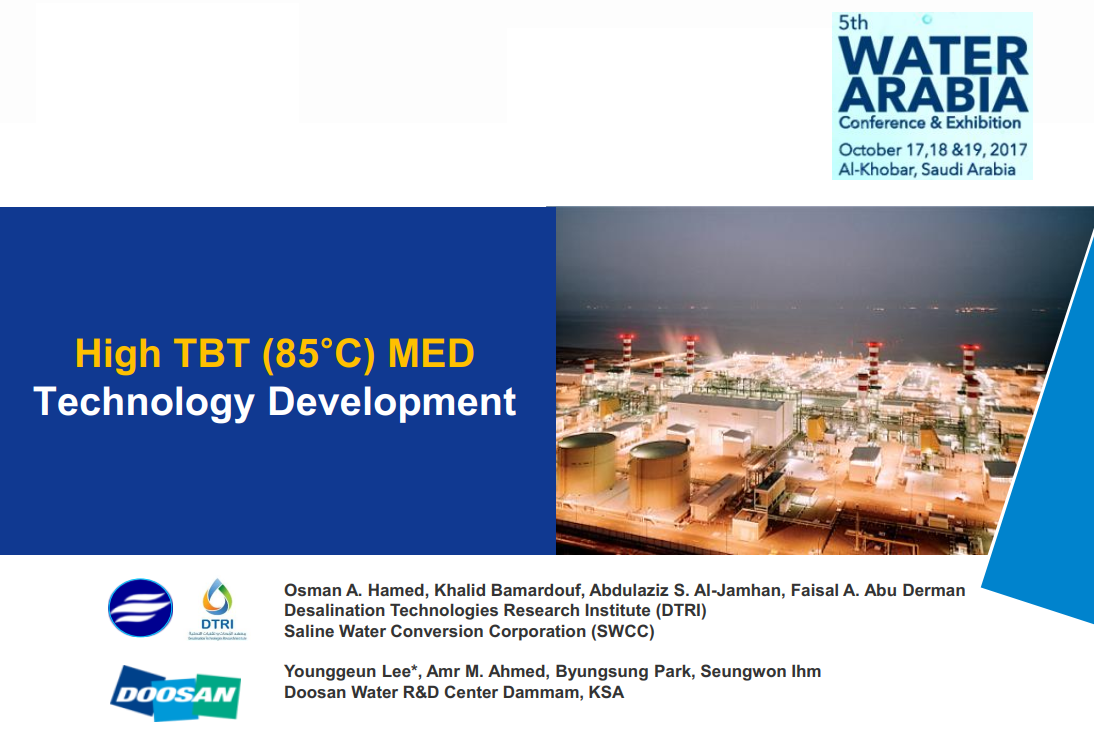
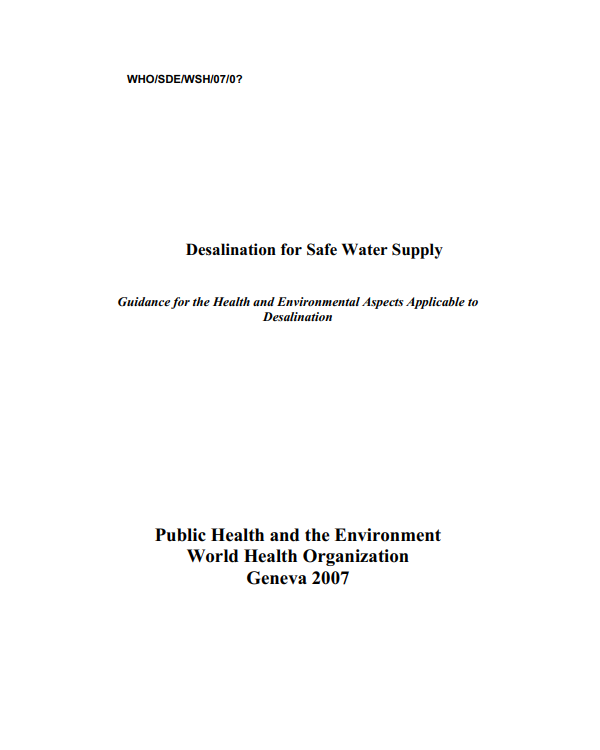

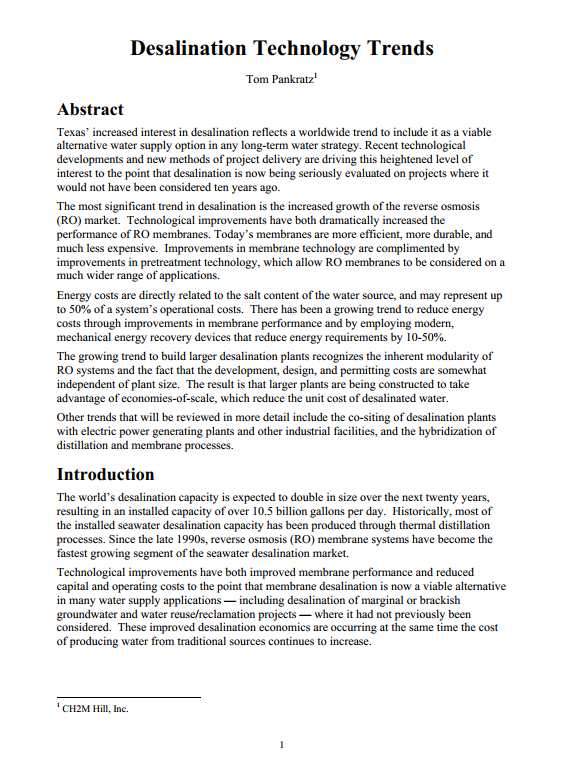

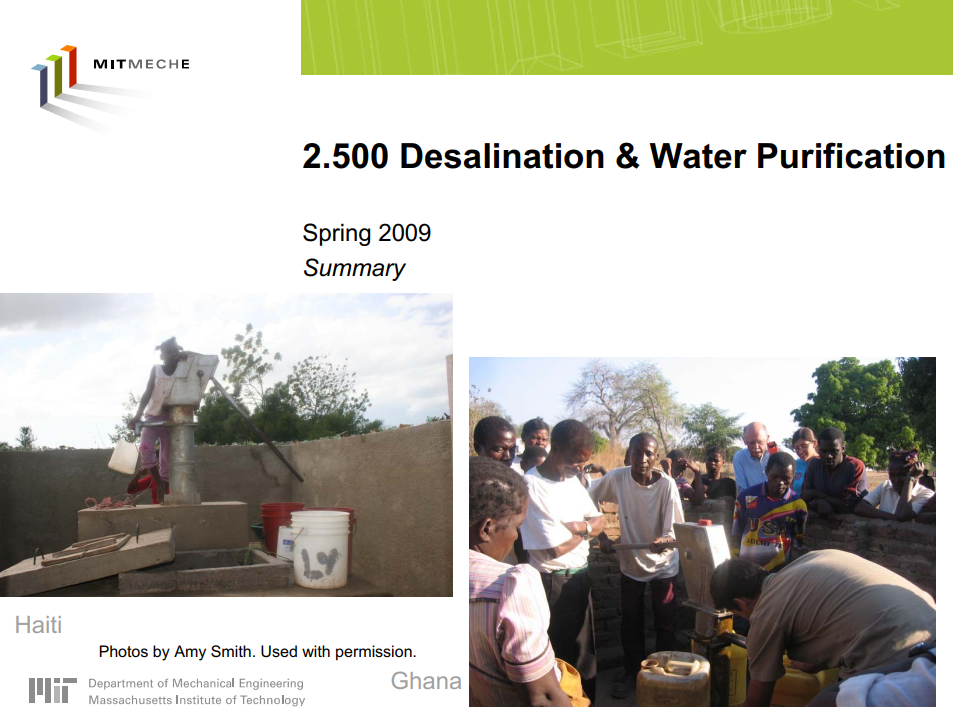
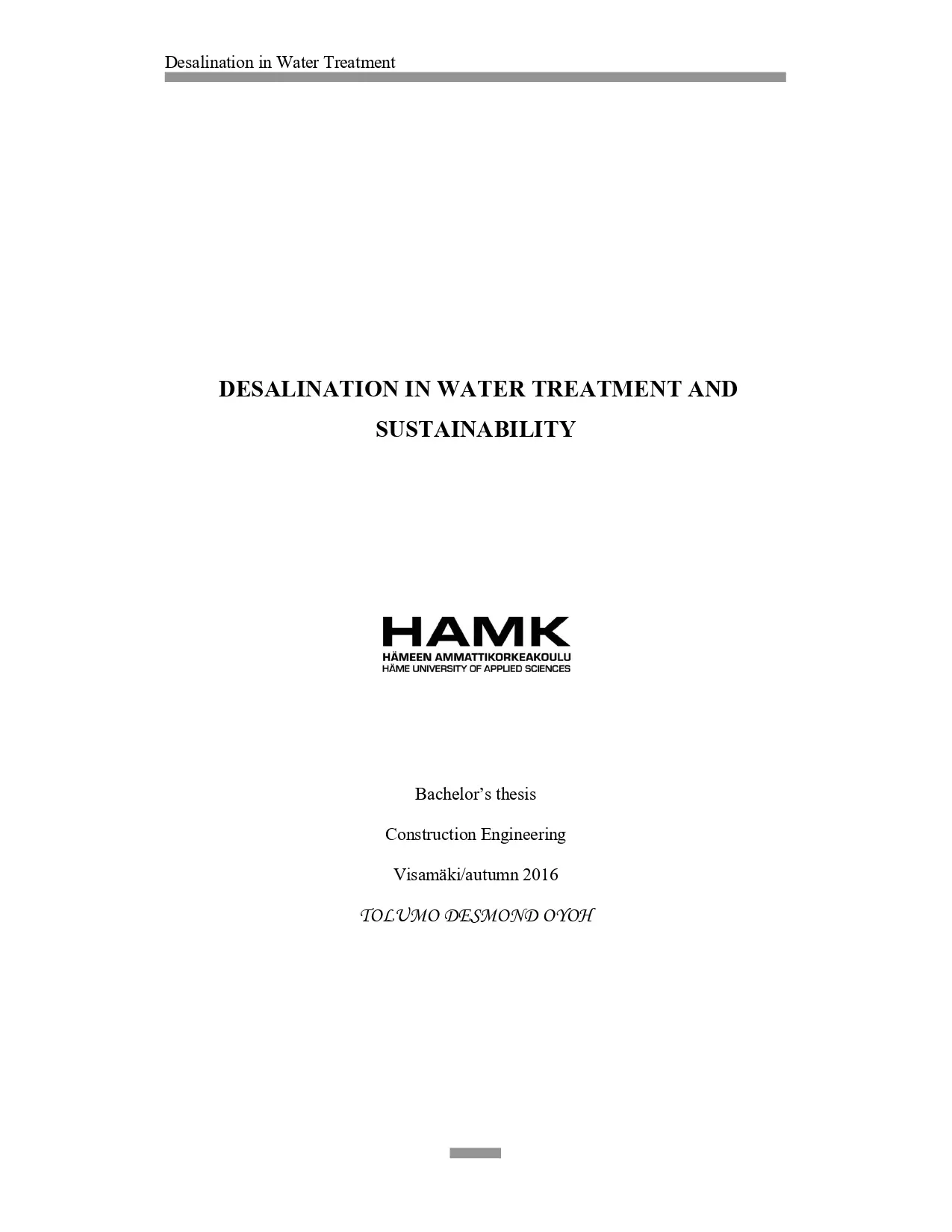
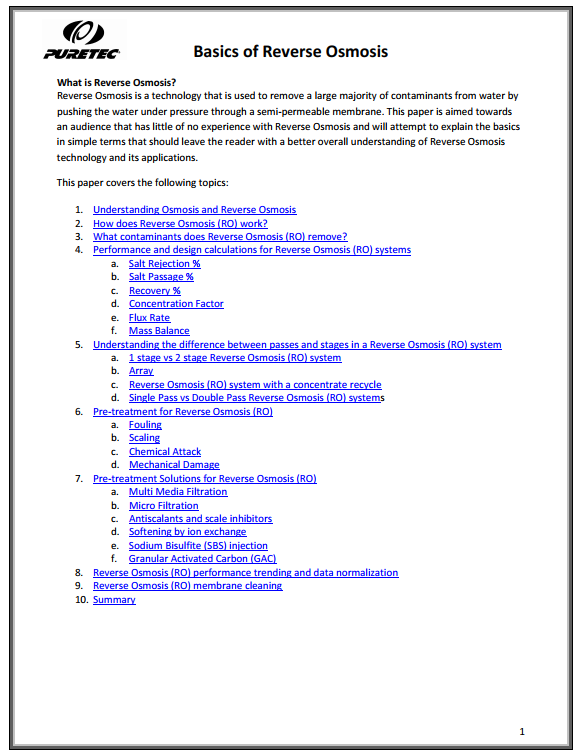




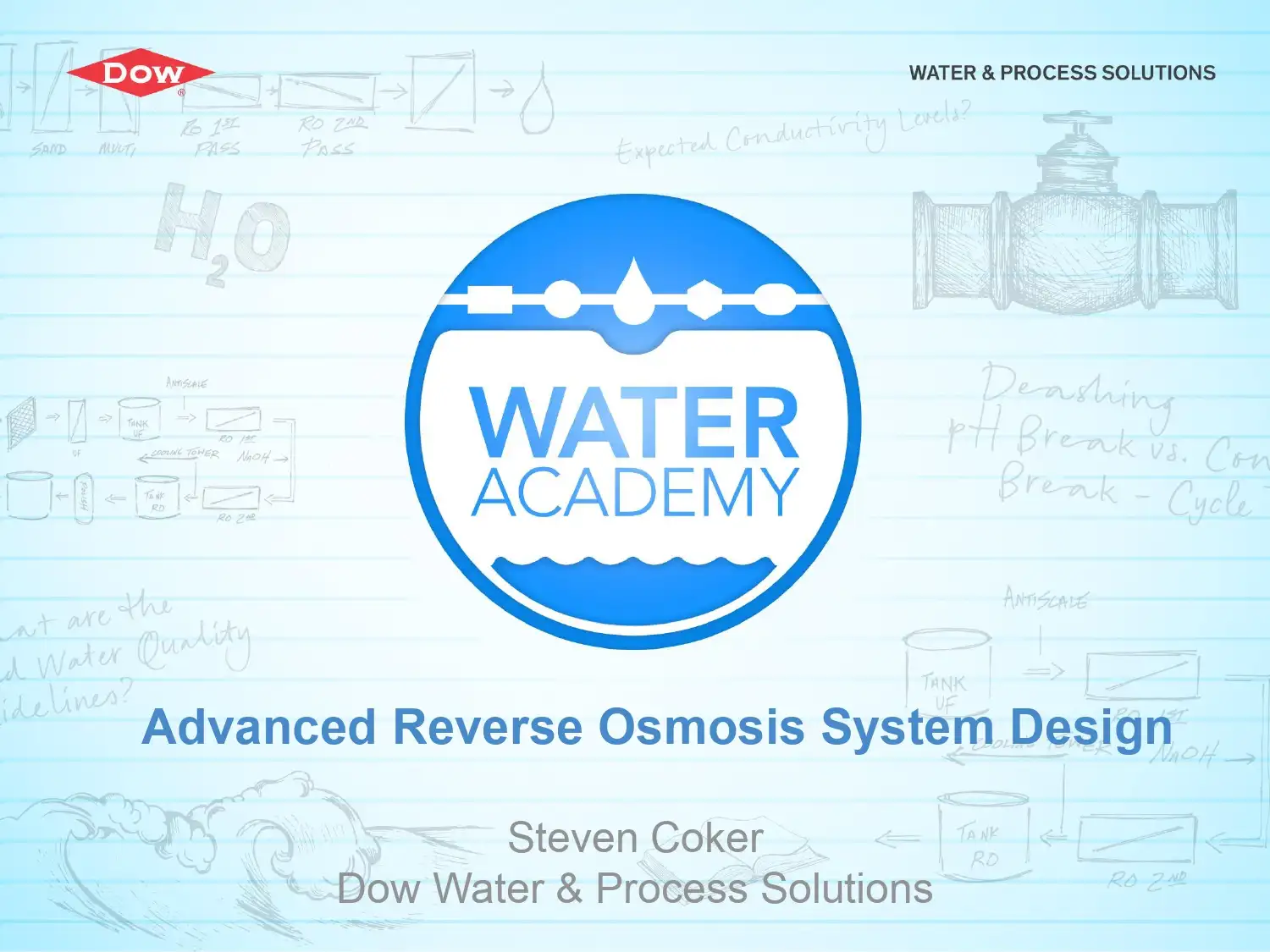
Reviews
There are no reviews yet.